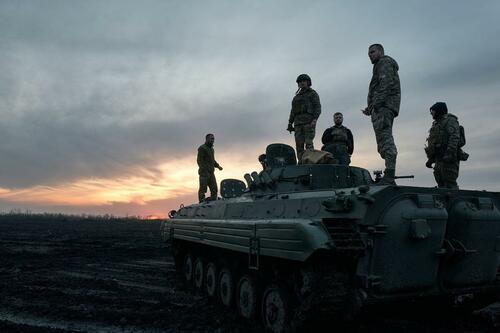With Biden's $60 billion in funding for Ukraine now fully authorized and implemented, the question is now what? The US President on Wednesday announced just after signing the bill that the Pentagon will start sending equipment to Ukraine "in the next few hours" straight from the US stockpile.
The Kremlin in response is vowing to push back the front lines deeper into Ukraine, and says that newly infused American weapons will burn. Russian Ambassador to the US Anatoly Antonov has said in fresh remarks that "The American aid won’t save Zelensky. New weapons will be destroyed, and the special military operation goals will be achieved."
The diplomat continued, "the military shipments of the US and its satellites have been burned, are being burned and will be burned by the Russian Armed Forces."
 Getty Images
Getty ImagesWednesday afternoon comments by Biden's national security adviser Jake Sullivan hailed that the long sought defense aid for Kiev has finally become a reality, but also cautioned that Russia could still break through Ukrainian defensive positions soon.
"It was a long road to secure this funding, and I have to say standing here today, it was too long, and the consequences of the delay have been felt in Ukraine," Sullivan told reporters, and explained that troops have had to resort to rationing ammunition, resulting in lost ground in the east.
"And while today's announcement is very good news for Ukraine, they are still under severe pressure on the battlefield. And it is certainly possible that Russia could make additional tactical gains in the coming weeks," he warned.
The reality is that Ukraine is fundamentally suffering a severe crisis of manpower. This essentially means that even as US weapons and equipment arrive, there are fewer and fewer troops experienced enough to actually man and operate them.
This is a grim trend which has especially been on display this week, for example in a Tuesday announcement by Foreign Minister Dmytro Kuleba, who said the government would be cutting off consular services for military-age men living abroad. The move is to encourage them to return home and fight for their country.
"How it looks like now: a man of conscription age went abroad, showed his state that he does not care about its survival, and then comes and wants to receive services from this state," the top diplomat wrote on X. "It does not work this way. Our country is at war."
"The obligation to update one’s documents with the conscription centers existed even before the new law on mobilization was passed," Kuleba also explained. The new policy requires that all men 18 to 60 must update their information with a state office - and if they don't comply then they get cut off from all consular services abroad.
According to The New York Times, US weapons could start arriving in Ukraine within days. But on parts of the front line, Ukraine's situation is desperate. And it still has a major problem that aid can't fix: a lack of troops.
"The most important source of Ukrainian weakness is the lack of manpower," Konrad Muzyka, director of the Rochan military consultancy in Poland, told Reuters. --Business Insider
Meanwhile, inside Ukraine military officials are trying to get creative amid the ongoing manpower shortage. Reuters reports, "As Ukraine's efforts to conscript enough men to fight Russia are stymied by public skepticism, defense officials and military units are embarking on a multi-pronged charm offensive to recruit a citizens' army to resist the invasion."
The “Experts” are finally admitting that Russia is winning the war in Ukraine, but they are still lying about why. The reason is not congressional inaction over further funding. The reason is that Russia has more manpower than Ukraine; it produces more artillery than the West;… pic.twitter.com/TnE7EuLEII
— David Sacks (@DavidSacks) April 16, 2024
"This softer call-up is being conducted on job-search sites and outreach centers, as well as billboards and social media, and offers a wartime novelty: an element of choice," the report continues. "Candidates can select their precise unit and roles suiting their skills, for instance, as well as how long they will serve."
And yet we are likely to still witness more examples of recruitment officers brutally seizing young men off the streets, as was seen at various times over the course of the first two years of the war.
Source link

